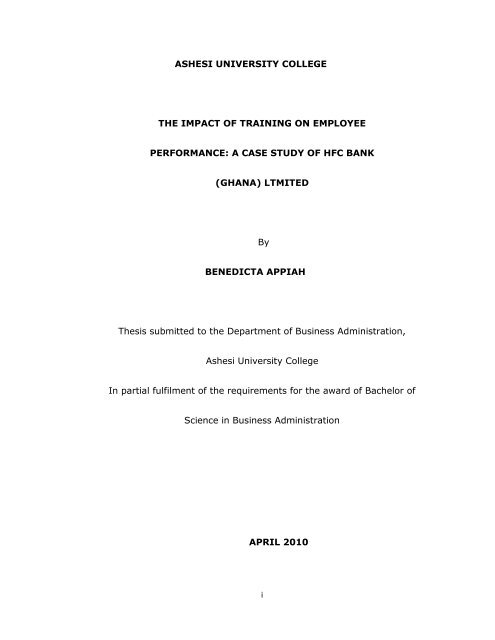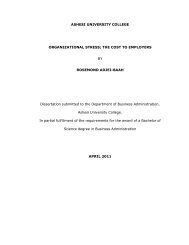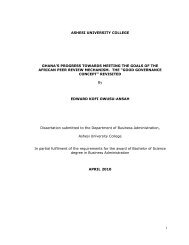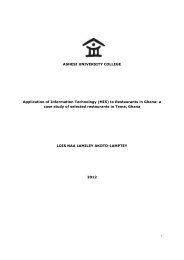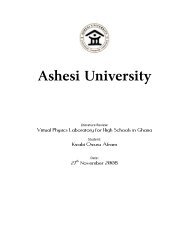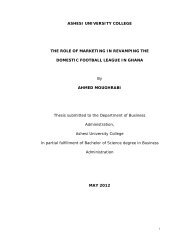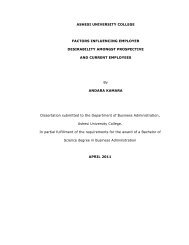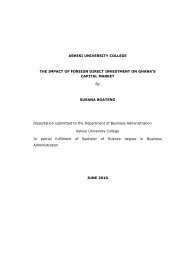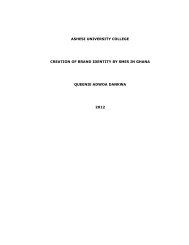BENEDICTA APPIAH.pdf - Ashesi Institutional Repository - Ashesi ...
BENEDICTA APPIAH.pdf - Ashesi Institutional Repository - Ashesi ...
BENEDICTA APPIAH.pdf - Ashesi Institutional Repository - Ashesi ...
- No tags were found...
Create successful ePaper yourself
Turn your PDF publications into a flip-book with our unique Google optimized e-Paper software.
ASHESI UNIVERSITY COLLEGETHE IMPACT OF TRAINING ON EMPLOYEEPERFORMANCE: A CASE STUDY OF HFC BANK(GHANA) LTMITEDBy<strong>BENEDICTA</strong> <strong>APPIAH</strong>Thesis submitted to the Department of Business Administration,<strong>Ashesi</strong> University CollegeIn partial fulfilment of the requirements for the award of Bachelor ofScience in Business AdministrationAPRIL 2010i
DeclarationI hereby declare that this dissertation is the result of my own original workand that no part of it has been presented for another degree in thisuniversity or elsewhere.Date: ……………………………….Candidate’s Signature: ………………….....Candidate’s Name: ……………………………………………I hereby declare that the preparation and presentation of the thesis weresupervised in accordance with the guidelines on supervision of thesis laiddown by <strong>Ashesi</strong> University College.Supervisor’s Signature …………………………………...Supervisor’s Name …………………………………………..Date …………………………………………..ii
AcknowledgementsSeveral people have been helpful throughout the whole process. I would liketo thank Fiifi Nana Banyin Mends who helped me in my data collectionprocess and also the Human Resource and Finance Managers, and staff ofHFC Bank who took time off to give me adequate information.I would also like to thank Mishael Offei who contributed in proof reading mywork.Finally I would like to acknowledge the contribution of my supervisor MsKajsa Hallberg Adu a lecturer of <strong>Ashesi</strong> University College for her constructivecriticisms that guided me till the end.iii
AbstractThe quality of the human resource of an organization is essential to itssuccess.Thus, every organization must seek to improve the quality of itsworkforce. One way of achieving this is through training. The importance oftraining can only be appreciated with a clear understanding of its directimpact on employee performance. An improvement in employeeperformance also leads to an improvement in the company’s performance. Itis in this respect that HFC Bank (Ghana) limited was analyzed to establish acorrelation between its training programs and the success of the company.Data was derived through questionnaires distributed to selected employeesas well as the finance and human resource managers. The results revealedthat HFC Bank had a comprehensive (planned and systematic) in housetraining program that every employee was aware of. The objective of theprogram is to improve both individual and organizational performance. Everyemployee no matter their educational background or level within thecompany had benefited from the in house training program. However, this isthe only form of training that exists. The firm is therefore advised to ensurethat the program is consistently evaluated to ensure its compatibility withglobal changes and changes within the banking industry. The possibility ofother forms of training like external courses should be considered to offeremployees choice also allowing those who benefit from external courses toiv
contribute their knowledge and observations to the existing system in thebank.Table of ContentsDeclaration ................................................................................................................. iAcknowledgements .................................................................................................... iiiAbstract ................................................................................................................... ivList of Tables ........................................................................................... viiList of Figures ......................................................................................... viiiCHAPTER 1: INTRODUCTION ....................................................................................... 11.1 Introduction ............................................................................................ 11.2 Background to the study........................................................................... 21.3 Problem statement .................................................................................. 41.4 Objectives of the study ............................................................................. 51.5 Research Questions ................................................................................. 51.6 Relevance of the study ............................................................................. 51.7 Scope and limitations of study ................................................................... 61.8 Chapter disposition .................................................................................. 6CHAPTER 2: LITERATURE REVIEW ................................................................................ 82.1 Overview of Training ................................................................................ 82.2 Training .................................................................................................. 92.2.1 Importance of training ......................................................................... 102.2.2 Best ways to develop training programs ................................................ 122.2.3 Determining training needs .................................................................. 122.2.4 Training Objectives and Plans ............................................................... 132.2.5 Evaluating training programs................................................................ 142.2.6 Types of training programs .................................................................. 152.3 Employee performance ........................................................................... 152.4 Relationship between training and employee performance .......................... 17CHAPTER THREE: METHODOLOGY .............................................................................. 203.1 Research Design .................................................................................... 203.2 Target Population .................................................................................. 20v
3.3 Sampling Size and Sampling Procedure .................................................... 213.4 Source of Data Collection: ...................................................................... 213.5 Research Instrument: ............................................................................ 223.6 Administration of the Instrument ............................................................. 223.7 Analysis of Data .................................................................................... 233.8 Limitations ............................................................................................ 23CHAPTER 4: PRESENTATION OF FINDNGS ................................................................... 244.1 Age distribution of Respondents .............................................................. 254.2 Gender of Respondents .......................................................................... 254.4 Job Position of respondents ..................................................................... 274.5 Years of Service in the Organization ......................................................... 274.6 Respondents’ awareness of training programs ........................................... 284.7 Participation in Training .......................................................................... 284.8 Selection for Training ............................................................................. 284.9 Respondents’ knowledge of training objectives .......................................... 294.10 Type of Training Received ..................................................................... 294.11 Respondents opinion on planned and systematic nature of training at HFCBank (Ghana) Limited .................................................................................. 294.12 Effects of training on employee performance ........................................... 304.13 Training and employee performance ....................................................... 314.14 Respondents opinion of the impact of training on the growth of the bank .... 324.15 HFC Financial Data ............................................................................... 32CHAPTER 5: ANALYSIS OF FINDINGS, CONCLUSIONS AND RECOMMENDATIONS ............. 345.1 Analysis of findings ................................................................................ 34Research Questions .................................................................................................. 415.2 Conclusion ............................................................................................ 425.3 Recommendations ................................................................................. 43References .............................................................................................................. 45Appendix ................................................................................................................. 47vi
List of TablesTable 1: Years of Service in the Organization ............................................................................. 27Table 2: Respondents opinion on planned an systematic nature of training at HFCBank (Ghana) Limited ........................................................................................................................... 29Table 3: Effects of training on employee performance ............................................................ 30vii
List of FiguresFigure 1: Educational Background .................................................................................... 26viii
CHAPTER 1: INTRODUCTION1.1 IntroductionThe purpose of this research is to identify the impact training has onemployee performance. The research is a case study on HFC Bank (Ghana)limited. Thus data will be collected through questionnaires distributed toemployees, the human resource manager and the finance manager toidentify whether training for employees exists and the impact on theperformance of employees. The banking sector was selected because it formsa significant portion of the service sector of the economy, which contributesabout 31.81% (Institute of Statistical and Social Research, 2008) of Ghana’sGross Domestic Product. This representation is high above the industrialsector (25.89%), (Institute of Statistical and Social Research, 2008) beingthe second best contributor to Ghana’s Gross Domestic Product (GDP). Theselection of HFC Bank is based on its position as the premier mortgagefinance institution in the country.The company requires employees withspecialist skills, the need therefore to identify the role training will play inimproving these skills. HFC Bank (Ghana) Limited, formerly Home FinanceCompany was incorporated on 7th May 1990, under the Ghana CompaniesCode 1963 (Act 179), as a private limited company and the premier apexmortgage financing institution in Ghana. It commenced business onDecember 2 1991. The company was by then promoted by the Governmentof Ghana (GOG), The Social Security and National Insurance Trust (SSNIT)and Merchant Bank (GH) Ltd.1
1.2 Background to the studyThe economic development of most developed countries such as Britain,Japan, China and United States of America can be attributed to the importantrole that its human resources have played. Therefore, considering the richnatural resources Ghana possesses and sufficient financial support, Ghanacan also attain this economic success if the needed attention is given to thetraining and development of human resource. The government is alreadytaking adequate steps to ensure that people acquire the necessaryknowledge and skills.According to Ocquaye (2004), this is exemplified with the provision ofprofessional and tertiary institutions, vocational training institutes andcolleges, secondary and technical schools, as well as the reforms ineducation. All these facilitate the acquisition of skills and knowledge toensure workplace effectiveness and efficiency.With these initiatives by the government, it is very essential for organizationsto offer systematic training and career development programs for theiremployees. This is because it is the people who make up the organization.Thus a manager in an organization cannot be successful until his teammembers are well equipped with skills, talent and knowledge.Training can be defined as a “systematic process of acquiring knowledge,skills, abilities, and the right attitudes and behaviours to meet jobrequirements” (Gomez-Mejia, et. al., 2007). Training has been reckoned tohelp employees do their current jobs or help meet current performancerequirements, by focusing on specific skills required for the current need.2
However, its benefits may extend throughout a person’s career and helpdevelop that person for future responsibilities.Current educational systems, do not necessarily impart specific knowledgefor specific job positions in organizations. As a result of this the labour forcecomprises of few people with the right skills, knowledge and competenciesneeded for positions in the job market. There is therefore the need forextensive external training for human resources to be able to improve andalso contribute to the productivity of organizations..In the Banking industry, human resources, skills and expertise are crucialassets that drive productivity and performance. This is because, as a serviceindustry, the service provided by the bank is delivered through its personneland it is consumed at the same time by the client. The bank personnel(human resource) stand for the service and portray to the customer thevalue and quality of the bank’s service (Aryee, 2009). As such, banks needexceptional human resources to present their services to customers in amanner that will win more customers and sustain profitability.Mr. Kwesi Bekoe Amisssah- Arthur, Governor of Bank of Ghana (BOG),affirms the need for banks in Ghana to train their human resource to ensureprofessionalism in order to restore the confidence of the public in the bankingsector. He says, there should be the need for training so that the humanresource will be more informed to educate customers so that benefits thatwill accrue to the financial institutions can be realized (Amisssah- Arthur,3
meet its human resource requirements for its corporate objectives, in theface of present challenges of skilled staff availability for the banking industry.This study is to assess the role of training on the human resource and howthis affects worker performance.1.4 Objectives of the studyThe objectives of this study are to –1. Identify existing training programs at HFC Bank2. Evaluate the effectiveness of these training programs.3. Discover if the training programs have impacted employee and thefirm’s overall performance.1.5 Research Questions1. What training programs does HFC Bank (Ghana) Limited have?2. What are the objectives of the training programs?3. Do the training programs meet their objectives?4. What is the impact that these training programs have had onemployee performance?5. Have the training programs contributed to the performance of thecompany?1.6 Relevance of the studyThe study will help firms understand the importance of training programs. Itwill also enable them structure their training programs to make them moreeffective in terms of helping to improve the efficiency of the workforce and5
lead to better performance. This also ensures the existence of a pool ofskilled workforce who could be utilized for national development. Labour is amajor input to the success of the company. If labour is efficient it will helpimprove the performance of the company. As companies perform better theyare able to increase output and contribute more to the economy. They arealso able to grow and hire more people thus helping to decrease the level ofunemployment. As companies perform better, they are also able to competebetter enabling the economy to remain vibrant.1.7 Scope and limitations of studyThe study is limited to the role and impact that training have played on theperformance of employees of HFC Bank (Ghana) Limited using their Headoffice branch as the focal point. The Head office branch constitutes animportant location of HFC Bank and holds a large population of employees. Acritical review of the situation should have involved a study of all or asignificant number of banks in the Ghanaian banking industry (at least 30%of the population – which is a minimum of 8 banks for the present total of 27banks). However, the scope of such study is beyond the capacity andresources of the researcher. Problems such as secrecy and indifference onthe part of respondents were limitations to the study.1.8 Chapter dispositionChapter OneChapter One will present theResearch Proposal, comprising of theBackground and Introduction to the study, the Problem Statement, Research6
Questions, Arguments for the study, Objectives of the Study,Significance/Relevance of the Study and the Scope / Limitations of the Study.Chapter TwoThis will present a comprehensive review of relevant literature in an attemptto position the study in an appropriate theoretical framework. Thus it willdiscuss findings of related researches to this study.Chapter ThreeThis chapter will present the methodology to be employed for data gatheringas well as the relevant statistical analytical tools that will be employed foranalyzing the survey results gathered during the study.Chapter FourThis section will present the findings from the survey, using the statisticaltools and methods chosen for data analyses.Chapter FiveThis chapter will be the concluding chapter, which will present the analysis ofthe findings, conclusions and recommendations for the study.7
CHAPTER 2: LITERATURE REVIEWThis chapter will present a comprehensive review of relevant literature in anattempt to position the study in an appropriate theoretical framework. Thus itwill discuss findings of related researches to this study.2.1 Overview of TrainingOne significant function of Human Resource Management to the effective useof human resources is training and development. Almost everyone nowrecognizes the significance of training on the success and growth oforganizations. Employees are however a very crucial and expensive resourceto every organization.There are significant changes today in terms of the value of the employee.Along with these changing values are the workplace trends that havesignificant impact on employees’ knowledge and skills. Training is thereforenecessary to enhance the knowledge, skills and attitude of employees. It willalso make it easier for employees to acquire further knowledge based on thefoundation gained from the training and further effect changes in other coworkers.In order to sustain performance there is the need for training in empoweringthe workforce to be creative and innovative. Training of employees will aid inthe productivity, profitability or survival of businesses in the presentcompetitive business environment. Training is therefore the key element insuccessful wealth creation.8
2.2 TrainingWhat is training?Training can be defined as a learning activity which is directed towards theacquisition of specific knowledge and skills for the purpose of an occupationor task. (Cole, 2002). The focus of training however is on the job or task tobe performed. For example, the need to have efficiency and safety in theoperation of particular machines.According to De Cenzo and Robbins (1996), “training is basically a learningexperience, which seeks a relatively permanent change in an individual'sskills, knowledge, attitudes or social behavior. This means that, there is theneed to improving employee’s skills and knowledge so that he or shebecomes efficient to work on both present and future jobs and tasks.Almost all organizations have recognized the importance of training to thedevelopment of their organizations. The birth of new technologies has madecertain jobs and skills redundant. As a result there is an increasing emphasison the need for a skilled and highly trained workforce. Many of the jobs andskills that have been replaced by machines, equipments and othertechnological devices are as a result of their unskilled nature, thus thisemphasizes the need for labor to attain more education and skills to be ableto secure employment in the future.For a training program to be successful there is the need for the organizationto identify the training needs of the organization. The organization canmeasure if the training has been successful or not if the trainees do not learnwhat they are supposed to learn, thus do not perform better than they used9
to. However, if trainees return empty from the course designed for themwithout any substantial contribution, it could also mean that even though theorganization might have done all that is necessary to ensure a successfultraining program, the wrong candidates might have been selected for thetraining program.Leaning takes place when the behavior of people changes based on theresults from experiences. (McGhee et al, 1996). Thus one can examine iflearning has effectively taken place by comparing individual’s behavior beforeon specific jobs and tasks to after experiences on jobs and task. It can,therefore be concluded that there is no learning if there is no evidentbehavioral change. Since training is generally intended to provide learningexperiences that will help employees attain more skills and knowledge, itmust follow the learning principle.Training thus can be defined as a learning experience which creates apermanent change in the skills, knowledge, and attitude of individuals on acurrently held job and also enables employees to gain knowledge which theycan transfer to other job areas.2.2.1 Importance of trainingTraining is a tool which helps organizations to gain a competitive edge.According to Krietner (1995) in his book The Good Manager’s Guide, nomatter how carefully job applicants are screened, typically a gap remainsbetween what the employee does know and what they should know. There is10
therefore the need for organizations to train their human resource to be ableto learn in order to acquire more skills and knowledge to beat competition.Training is a key element for improved organizational performance throughthe increasing level of individual competences. This means that training willhelp employees to master knowledge, skills, behaviors, sense of self worthand confidence upon which they are able to perform efficiently to improve onthe performance of the organization.Among the many benefits of training, training can also eliminate risks inorganizations because the trained personnel will be efficient, thus will be ableto make better use of the organizations property thereby reducing andavoiding waste. Training will also make the employees feel a sense ofsecurity thus labor turnover can be avoided. According to Cole (2002)training can achieve lower cost of production, lower turnover and changemanagement.There exists a gap between desired targets or standards and actual levels ofwork performance in every organizational setting. This means that there canbe both a negative and positive relationship between what should happenand what actually happens in terms of the work performance in anyorganization. There is therefore the need for every organization to adoptstrategies in order to achieve the desired targets or standards set by thecompany. Training can be one tool that organizations can use to reach theirtargets or standards.11
Although many organizations continue to have doubts about the cost oftraining, the development of skills, knowledge and attitude of employeestowards their jobs or tasks will be one of the greatest tools through whichorganizations can make employees work more efficiently and beatcompetition to reach the desired targets and standards of the company.(Casio, 1989) puts it this way “The economic and technological trends, thepace of innovation, change and development have been growing faster yearby-yearand as a result, these are clear signals that training anddevelopment are very important that both organizations and individualstakeholders must consider as very serious”.2.2.2 Best ways to develop training programsThe best way to develop training programs is to go through the trainingprocess. That is training needs identification, training plans andimplementation, evaluation or training feedback.2.2.3 Determining training needsTraining needs analysis answers the questions, who if there is, needstraining? And what training should be given? There is therefore the need forany organization to first identify the training needs of the organization. Theneed for training should be identified in accordance with a well organizedprocedure looking at the training needs from the organizational andemployee perspective.Based on the organizational analysis, the organization can assess the level ofgrowth over a defined period of time and then determine the shortfalls andproblems in order to help determine the required training programs. Also in12
identifying the training needs from the employees’ perspective, theorganization can measure the performances of individual employees. This canbe measured by analyzing the efficiency of the individual employees againstthe required standards set by the organization through frequent performanceappraisals.The difference in the organization and employees actual results expected aswell as feedback from customers and shareholders of the organization all canhelp identify training needs. However this will depend on the circumstancesthe organization may find itself.Training need arises where there is the need to improve or adapt/adjust tochanges and solve problems in order to improve on both employee andorganizational performance. The purpose of a training needs identificationprogram therefore is to identify the gap that exist between the required andthe actual competencies expected of organizations and employees so as todetermine the kinds of training that can help bridge the gap (Asare-Bediako,2002).2.2.4 Training Objectives and PlansThere is also the need for the organization and the employees to know themotive for which they undergo training. It can, therefore be concluded thattraining programs will not be more effective unless the purpose for which itwas administered is known.Therefore in planning training, it should gothrough these stages; develop a training plan, designing a training lesson,selecting the trainer and prepare the trainer. (Zaccarelli, 1997).13
The training plan will serve as the guidelines for both the trainer and thetrainee to follow in order to successfully implement the program. It coversthe individuals involved in the training, the person that will administer theprogram, the required resources and the content to be followed. Once theplan for the program has been outlined then the training lesson is designed.The training lesson is developed to help the participants focus on thesegments developed and also set out the time frame for each segment. Afterthis, a competent trainer is hired to undertake the training. The trainershould be able to communicate and transfer knowledge effectively. Finally, itis very important that the trainer will be able to communicate and transferthe skills and knowledge effectively so that the needed impart is realized.Thus the trainer should be well prepared to take on the task in order toachieve the desired results.2.2.5 Evaluating training programs.In measuring the overall effectiveness of the training program there is theneed to also consider the costs and benefits of the training program. This willhelp the organization know whether there has been effectiveness in terms ofprofits. Evaluation should take place before, during and after the trainingprograms. According to Kenney et al (1992) review of the training programshould be done during and after its completion and should be done by atraining officer, the line manager, and the trainees themselves. Training canbe evaluated in so many ways. Some of these are through questionnaireswhich will serve as the feedback from the participants; case studies where14
the participants will have to apply the learned skills to practical situationsand many others.2.2.6 Types of training programsThe kinds of training selected by each organization should depend on theobjectives and the level of education and position of employees in theorganization. Some of these are the job training, orientation training andcareer development training.Job TrainingThis helps employees develop the skills, knowledge, the right attitude andexperiences needed on the job and involves teaching the employees how towork on the job hired for.Orientation TrainingThis is given to newly hired employees to induct them into the organizationand also train them on the job they will hold. The employees are thought theculture, values, mission and processes and activities followed in theorganization.Career Development TrainingThis is also given to employees at all levels in the organization to preparethem for future changes, new venture creations and responsibilities.2.3 Employee performanceWhat is employee performance?Employee's performance means how well employees perform on the job andassignments assigned them measured against the generally acceptedmeasure of performance standards set by their companies. This means thereare general expectations expected of employees in relation to their15
performance in every company. Employees can be said to have performedwhen they have met the expectations and performed up to standard.Employee performance can also be defined as the functioning andpresentation of employees. This means, how employees are able toeffectively administer their task and assignments and also how they presenttheir assignment to reflect the quality and good service desired by theircompanies.2.3.1 Evaluation of employee performanceWhen evaluating the performance of employees, it is very important to havea check list that will be used consistently in measuring the performance of allemployees.The techniques for measuring the performance of employeesmay differ from every company. Some of these evaluation techniques are:Ambition / InitiativeIs the employee able to show he has a vision and goals towards his job andmakes the imitative to achieving these goals and vision.Attitude / CooperationDoes the employee have a positive attitude towards his fellow employees andhis work and also he is able to work on different task?Communication skillsIs the employee able to communicate effectively with other employees andcustomers? Has he been able to solve issues due to his communication skills?16
FocusWhether the employee is focused on his job and is able to distinguish his taskfrom personal assignments.2.4 Relationship between training and employeeperformanceWhat people have said about training and employee performance?The information thus far reveals a seeming consensus in the belief that thereis a positive relationship between training and employee performance. Thustraining impacts positively on employee’s performance by generating benefitsto both the employees and the organization they work for through thedevelopment of skills, knowledge, abilities, competencies and behavior.Training plays a significant role in the development of organizations,enhancing performance as well as increasing productivity, and ultimatelyputting companies in the best position to face competition and stay at thetop.This means that, there is a significant relationship betweenorganizations that train their employees and organizations that do not.According to Neo et al in his book Human Resource Management: GainingCompetitive Advantage in 2000, “he stated that only 16% of United Statesemployees have ever received any form of training from their employers”.From the researcher’s point of view, there is a possibility that in about five ormore years to come the rapid development in technology can cause highunemployment rate because these forms of technology will replace theunskilled labor in the United States. There is therefore the need for UnitedStates to put strategies and policies in place to ensure that its humanresource is trained in order to meet the standards of the growing technology.17
In realization of this, General Electric, Texas Instruments and FederalExpress have already made the initiative and now invest between 3% and5% of their payroll in training.Every organization that is committed to generating profits for its owners(shareholders) and providing quality service forits customers andbeneficiaries invest in the training of its employees. (Evans and Lindsay1999). According to Robert Simpson Managing director of Legna ConstructionLimited , a construction company located in the central region of Ghanawhich contributes substantially to the development of the country through itsroads construction and employment of the country’s human resource,training of the company’s human resource contributed to the companygaining substantial increase in revenue from 2005 – 2009. (40% increasefrom 2001 – 2004). He attributed this to the skills and knowledge theemployees gained through the training that helped them be more efficientthus reduced cost on the job thereby gaining more revenue. Evans andLindsay (1999) also stated that, Motorola & Texas Instruments provide atleast 40 hours of training to every employee quarterly and this hassignificantly impacted on the employee performance.Companies committed to investment in their human resource generate longterm and sustainable profitability for the company. In a study in America onthe impact of human capital investments such as employer-provided trainingand development, Black and Lynch (1996) citing Bartel (1989) stated that“returns on training and development investments increase productivity by18
16%”. This further reinforces the role of training on employees. Based on theattributes that are developed the employees implement them on their tasksand thus the company is able to improve thus generate the profits for thefirm. Also because the attributes are imparted and developed through thesystematic and planned training program, it becomes a part of theemployees thus they are able to implement them on every task thus theincreased profit leading to sustainable profitability.The review has revealed the importance and purpose of training inorganizations, and how it contributes to employee performance. The essenceof training needs, how and why training needs should be assessed has alsobeen explained. The bases for which employees should be chosen or selectedfor training, the types of training have been duly identified namely jobtraining, orientation training and career development training.19
CHAPTER THREE: METHODOLOGYThis chapter will present the methodology to be employed for data gatheringas well as the relevant statistical analytical tools that will be employed foranalyzing the survey results gathered during the study.3.1 Research DesignThe study is in the form of cross sectional study in which data was collectedonce across a population through sampling. The questionnaires wereadministered to thirty employees who were selected using the conveniencesampling technique. The questionnaires were administered by arepresentative from the bank to the respondents. The list with the names ofthe employees was used in selecting every 4 th employee to participate in thestudy.Two extra questionnaires were also used to gather information on the subjectfrom the Management of HFC Bank on:existence of structured trainingprogrammes for employees, how long they have been running the trainingfor their employees, the profit per unit of labor from 2004-2008. The HumanResource and Finance Manager at the head office provided the informationneeded.3.2 Target PopulationThe target population was the employees of HFC Bank (Ghana) limited thehead office branch at Ridge comprising of the middle and upper levelmanagement. This is because the head office branch employs the largest20
number of employees out of the total number of employees represented inGhana.3.3 Sampling Size and Sampling ProcedureA sample size of 30 was used made up of 10 employees from the upper levelmanagement and 20 from middle level management. Even though the studyshould have covered a lot more of the employees, the size of 30 was chosenbecause of time and financial constraints.Sampling procedure:i. 30 employees out of the total number of employees at the Head officebranch (Ridge) were included in the study. These 30 respondents werechosen by a representative from the bank with a list of the names of theemployees selecting every 4 th employee.ii. 30 employees were administered with the questionnaire using theconvenience sampling selection method and only 22 returned theirquestionnaire.3.4 Source of Data Collection:Data for this study was obtained from primary and secondary sources. Thesecondary data was gathered from the banks corporate plan and reviewreports on Human Resource Management. Out of the 30 employees sampledtwenty-two completed and returned their questionnaire. Primary data wassourced from questionnaires given to the employees, Human ResourceManager and Finance Manager. These questionnaires provided information onhow long the bank have been running training programmes if the bank hastraining programmes, the performance of the bank and the profit per unit of21
labor. Copies of the questionnaires are attached as Appendix 1, Appendix 2and Appendix 3.3.5 Research Instrument:Three questionnaires were developed for the study. The first questionnairewas administered to 30 employees; this questionnaire was finalized afterdiscussion with my supervisor and thorough editing taken into considerationthe research questions. The questionnaire directly addressed the researchquestions. Questions 1-3 was expected to provide an answer to the age,gender and educational background of the respondents. Questions 4-12 ofthe questionnaire were to elicit information on training programs available atHFC Bank, 13-21 was also to provide information on the benefits of thetraining to employees.The second questionnaire was to the Human Resource Manager. It wasexpected to provide information on the banks training programmes, thenumber of years it has been practiced and also the performance of the bank.The third questionnaire to the Finance Manager was expected to provideinformation on if there has been an increase in the hiring of employees from2004-2008, how has the increase impacted on the company’s performanceand also the profit per unit of labor from 2004-2008.3.6 Administration of the InstrumentThree questionnaires were administered to employees of HFC Bank, theHuman Resource Manager and the Finance Manager of the head office branchof the bank located at Ridge in Accra, Ghana. A total of 30 questionnaires22
constituting 21 designed questions were administered by a representative toemployees at convenience.The second questionnaire constituting 5 was also filled by the HumanResource Manager and the third questionnaire constituting 3 was filled by theFinance Manager. The Employees as well as the Human Resource Managerand the Finance Manager were given three days to fill out the questionnaires.3.7 Analysis of DataBoth quantitative and qualitative data were collected. The qualitative datafrom secondary sources were analyzed using content analysis and logicalanalysis techniques.Quantitative data analysis was done using MicrosoftOffice Excel 2007. Frequency distribution and percentages were used for thequantitative data analysis. It was used to determine the proportion ofrespondents choosing the various responses. This was done for each group ofitems relating to the research questions. The proportions showed the diverseviews of employees on the various sub-issues. Tables, charts and graphswere also used to ensure easy understanding of the analyses.3.8 LimitationsThere could have been other methods through which data could have beenobtained from the human and finance managers however they were notavailable, thus the researcher had to provide the questions for them in theform of the questionnaire to obtain the data.23
CHAPTER 4: PRESENTATION OF FINDNGSThis section will present the findings from the survey, using the statisticaltools and methods chosen for data analyses with summarised analysis on theresults.Problems such as secrecy and indifference on the part of respondents werelimitations in the collection of data. Since the bank is a formal organization,the letter of approval for the survey to be done had to go through the headmanagers of the bank. As a result of this, it took a long time beforepermission was granted for survey to be done.8 respondents failed toanswer the questionnaire. Reasons given included lack of time due to heavyworkload at work or the questionnaires not getting to them on time.Even though the sample size chosen was rather small, when taking intoconsideration the number of HFC Bank employees, it had to be used toensure that at least some data could be collected on time to ensure thetimely presentation of the paper. Thus, a further reduction of respondentsdue to the eight unanswered questionnaires reduces further the quality ofdata collected.The company did not provide any information on the annual headcount of thecompany and explained it was confidential and they could not disclose anyinformation on that.24
4.1 Age distribution of RespondentsThe ages of the respondents ranged between 26 and 55 years. It reveals thatnone of the 22 respondents fell within the age range of 18-25 and 56-59.There were 13 respondents between 26-35 years representing 59.1%. 5 ofthe respondents were between the ages of 36-45 representing 22.72%. Thefinal 4 respondents were between 46-55 years representing 18.18% of thetotal respondents. The non representation of respondents between 18-25 and56-59 does not mean the bank does not have employees within the range, itonly means the employees within the age range were not available torespond to the questionnaire.4.2 Gender of RespondentsOut of the 22 respondents 13 were males representing 59.1% and 9 werefemales representing 40.9 %. This shows that the male respondents formedthe majority. In contacting a few of the employees I discovered that thestatistics above corresponds to the current situation in the bank. Currently,there are more male employees in the bank than females.25
4.3 Educational Background of RespondentsFigure 1: Educational BackgroundSource: Field data March 2010The x-axis represents the frequency and the y-axis respondentsFrom the table above, it can be observed that about a fourth (63.64%) of therespondents have a first degree, 2 representing 9.09% have a mastersdegree, 4 representing 18.18% have multiple degrees, whilst 2representing 9.09% have other forms of qualification besides a first degreeor masters. It can therefore be concluded that to be employed in a middle orupper level position in the bank one has to have no less than a first degree.26
4.4 Job Position of respondentsThe study covered only upper and middle level management of the bankincluding the Human Resource and Finance managers. The middle levelmanagement respondents were 16 representing 72.73% whiles the upperlevel management were 6 and also represented 27.27%. The analysis showsthat a larger proportion of the respondents were found to be from middlelevel management. HFC Bank (Ghana) Limited can therefore be described ascomprising workers of varied positions all working towards the attainment ofthe company’s goals.4.5 Years of Service in the OrganizationTable 1: Years of Service in the OrganizationYears of Service Frequency Percentage1 – 3 5 22.73%4 – 5 10 45.45%6 - 9 7 31.82%10 – 12 0 0%TOTAL 22 100%Source: Field data March 201027
From the table above, the respondents have served in HFC Bank (Ghana)Limited from 1 to 9 years. It can be seen that respondents who have servedfor 4-5 years representing 45.45% formed the majority whilst respondentswho have served for 6-9 years followed with a frequency of 7 representing31.82%. The remaining respondents who have served for 5 years make up22.73%. However none of the respondents fell within the range of 10-12years of service in the bank.4.6 Respondents’ awareness of training programsAll the respondents who participated are aware of training programs at HFCBank. Thus 22 responded YES representing 100% and 0 for NO representing0%. The fact that all respondents were aware of the existence of trainingprograms within the institution reveals that these programs are wellpublicized. This is a necessary premier factor in the development of aneffective program.4.7 Participation in TrainingAll the respondents have participated in one form of training or another. Allthe 22 respondents representing 100% have participated in trainingprograms. Thus we can conclude that it is likely that one has gone throughsome form of training no matter the years spent with the institution.4.8 Selection for TrainingAll 22 respondents answered that the selection for training was done by theHuman Resource Manager.28
4.9 Respondents’ knowledge of training objectivesAll the 22 respondents indicated that the objective of the training programsby the bank was to help improve employee performance and also to help theemployees acquire more skills. However out of the 22, six also added thattraining was to facilitate promotion, learn about advancements in theindustry and also an opportunity for employees to brainstorm in order todevelop strategies for the bank.4.10 Type of Training Received22 of the respondents indicated that all training takes place internally. Newemployees do receive orientation training, all employees undergo periodic joband career development training.4.11 Respondents opinion on planned and systematicnature of training at HFC Bank (Ghana) LimitedTable 2: Respondents opinion on planned an systematic nature of training at HFCBank (Ghana) LimitedRESPONSE FREQUENCY PERCENTAGEYes 20 90.90No 0 0Not sure 2 9.1TOTAL 22 100%Source: Field data March 2010It can be observed from the table that, 20 respondents representing 90.90%affirmed training at HFC Bank is planned and systematic, 2 of the respondentrepresenting 9.1% indicated they were not sure whiles none of the29
ambition, initiative and focus.Motivation results in focus and a drive tosucceed and excel.Opportunity for personal developmentEven though some of the employees stated they are not motivated by thetraining activities they all indicated that they have gained some form ofknowledge as a result of the training. This reveals that employees are beingequipped to aid in the growth of the business. The fact that all employeeswere able to state clearly how they have been impacted by the trainingreveals the effectiveness of the training programs.There are objectivesinvolved in training and if participants are able to identify the objectives aswell as state how these have been met then it highlights how well structuredthe program is.4.13 Training and employee performanceRespondents’ opinion of the effect of training on employeeperformanceRespondents’ response on the effect of training on employee performancecan be summarized as resulting in improvement of skills, the acquisition ofnew knowledge, increase in efficiency and better performance. This agreeswith De Cenzo and Robbins (1996), who stated that “training is basically alearning experience, which seeks a relatively permanent change in anindividual's skills, knowledge, attitudes or social behavior.”31
4.14 Respondents opinion of the impact of training onthe growth of the bankAgain all the respondents are of the view that the training they haveundergone has enabled them contribute to the growth of the bank. Thisaffirms the need to train employees’ in order to improve not only onemployees’ skills and performance but also meet the growth objectives of thebank.4.15 HFC Financial DataWhat has been the annual headcount since 2004?2004 – N/A2005 - N/A2006 - N/A2007 – N/A2008 – N/AWhat has been the annual profit of the firm since 2004?2004 - 1,801,4312005 - 827,7162006 - 1,281,1552007 - 3,129,0372008 - 6,014,551What has been the annual turnover since 2004?2004 - 11,124,6102005 - 11,211,6632006 - 15,021,3232007 - 26,908,8142008 - 44,683,49432
Total Expenditure since 20042004 - 9,323,1792005 - 10,383,9472006 - 13,740,1682007 - 23,779,7772008 - 38,668,943Information on the annual headcount of the company was not providedbecause the company said it was confidential. Annual turnover increased by333.9% between 2004 and 2008. During that same period turnoverincreased by 401.7% and expenditure by 414.8%.Further investigationsrevealed that the huge increase in expenditure was as a result of a massiveexpansion of the company. To have pursued this whilst increasing turnoveras well as profit is a credit to the firm’s management.33
CHAPTER 5: ANALYSIS OF FINDINGS,CONCLUSIONS AND RECOMMENDATIONSThis chapter will present a detailed analysis of results, conclusions andrecommendations for the study in answering the research questions. It startsby addressing the research questions, and then gives the conclusion basedon the analysis from the results followed by the proposed recommendations.The study covered twenty-two employees of HFC Bank’s Head Office. Out ofthese 22 respondents 13 of them were males and the rest of the 9respondents were females. This statistics corresponds to the currentrepresentation at the bank. However there was no distinct pattern inresponses provided by the two groups. Both categories of respondentsresponded in the same way to the questions in the questionnaire. Theresearcher however expected that, the respondents from the upper levelmanagement might have undergone more diverse training than therespondents from the middle level management. However from the results,both the upper level management and the middle level management haveparticipated in training provided in house.5.1 Analysis of findingsInvolvement of HFC Bank (Ghana) Limited in training activities sinceits inception.Data collected revealed that HFC Bank started introducing its trainingprogram at the time the company began its operations, that is fromDecember 2 1991 and training continues till date. Most employees have hadsome form of training.34
As a growing organization in the early 1990’s, it was clear to the promoters;the Government of Ghana (GOG), SSNIT and Merchant Bank (Gh) Ltd thattraining could be used to induct new employees that are hired and alsoimprove performance and efficiency of existing employees.Objectives and Purpose of Training at HFC Bank (Ghana) Limited.The research revealed that the purpose of training and developmentactivities at HFC Bank (Ghana) Limited is to achieve both individual andorganizational performance. However the basic purpose of training as shownfrom the literature review is to improve the knowledge and skills ofemployees. It is also to change the attitudes and behavior of the employeesfor the purpose of enhancing the effectiveness of the organization as a wholeand increase performance.The rapid changes in technology also require that employees possess theknowledge, skills and abilities needed to handle the new processes andproduction techniques in order to be ahead of other competing organizations.Thus, there was the need to find out the major purposes for which HFC Banktrains its employees because reasons may differ per organization.According to the Human Resource Manager, employees at HFC Bank (Ghana)Limited are trained in order to improve their skills, knowledge, abilities,competencies, behavior and confidence. The ultimate objective however is tohelp improve both individual and organizational performance. Thus one canobserve that the purpose of training at HFC Bank (Ghana) limited is in linewith the general purpose of training from different literature reviewed.35
Selection for TrainingTraining at HFC Bank (Ghana) Limited dates back to the time the bankcommenced business. It can also be seen from the responses from the tableabove that all respondents have participated in training in one form or theother at the bank. However, it is very important that employees are selectedfirst by the identification of needs for each employee. This section found outhow the respondents were selected to undertake training programs. From theresearch the selection for training was by the Human Resource Manager.Employees believed that they are selected for training as and when theHuman Resource Department identifies the need for each employee toenhance their knowledge in order to meet standards, changes and also gainmore diverse skills to help in the development of the bank. This reveals anaspect of the structure of the program.Objectives of TrainingIt is very essential that the employees who undergo the training know theobjectives for each training program they undertake. Employees’ knowledgeof the reason for which they undergo training will help them be focused andenable them appreciate the program. It will in the long-run also reflect in thegrowth of the bank through the profits, reduced time periods on the jobamong others. The bank however is also certain and confident of a strongemployee base who are ready to work under changes in the banking sectorthat may occur and also replace the experienced employees who may retireor leave the business.36
The human resource manager stated that the objective for which theiremployees undergo training is to help them improve on their performance,acquire more skills, meet the required standards in the banking industry, asrefresher courses to learn their processes and procedures so they becomemore efficient. The respondents also affirmed this, all the respondents saidthe objectives are to improve on their performance an also enable themacquire new skills. Some out of the 22 also added that the training programsare to enable them work on a higher task based on a promotion; learn a newadvancement in the industry and also an opportunity for them to brainstormin order to develop strategies for the bank.Types of TrainingThe data revealed that HFC Bank only has an in-house training program forits employees. The possible benefits of this is that first of all havingintroduced the program since the inception of the bank one can assume thatthe program would have been improved over the years to make it moreeffective. Time would have allowed management to continuously evaluatethe effectiveness of its program and to consistently tweak it so as to make itmore efficient.The program being In-house also allows management tocustomize the program so as to enable it contribute to the attainment of theentity’s overall objectives.Management would also be able to access theunique needs of its employees and structure the program as to cater for itsneeds.However, one may also point out that the existence of only the in-houseprogram can pose a limitation.If programs were varied then employees37
having choices can make a selection that best suits their personal goals andobjectives.With employees having the option of external courses forexample, they can gain some exposure in ideas and practices probably notexistent in the bank and then transfer this knowledge when they return tothe job. With this the bank creates a system where they obtain feedbackbased on employee experiences as they participate in other trainingprograms thus ensuring that the institution stays abreast with developmentsnot only in their sector but globally that they can utilize to their benefit. Theresearch also revealed that training at the bank is formal, organized, andstandardized.Effects of Training on employee performanceEmployees are motivated to work better on the job if they are made to feeltheir employers think of their well-being. Training is one strategy thatemployers can however adapt to make employees feel this way. Whenemployers put in place training programs for their employees, they becomeaware of the desire of their employers to see them improve, thus will bemotivated to work better. Therefore, the study sought the opinion of therespondents whether they are motivated and satisfied with the trainingprogram of the bank.The results shows that, majority of respondents are motivated and satisfiedwith the training programs provided by the bank. It is very important thatthe employees are motivated and satisfied with the training programs put inplace by the bank. This is because being motivated will boost their morale38
thus enabling them to work hard to achieve the corporate goals and missionof the bank and help them live up to the institutions corporate values.It is vital in accessing the effectiveness of the training programs provided bythe bank to not only obtain the perspective of management but the trainees(employees) as well. The data revealed that employees were able to identifyspecific improvements to their development as a result of the training theyhave obtained and were also able to clearly state that the training providedover the years has been beneficial to them in terms of the improvement aswell as the acquisition of new skills and knowledge, improved efficiency andalso believed that training had enabled them contribute to the growth of theinstitution.Their ability to clearly identify these things highlights theeffectiveness of the training provided.Impact of employee training on the performance and growth of thebankLabour is a major input in the operations of any entity. Efficient labour has adirect impact on the output of the firm and productivity of the firm. Analysisof productivity can be simplified by accessing the output per unit of input.The more output per unit of input the more productive a firm is. The mainfocus of this study is on employee training and development and the impactof such skills, knowledge, efficiency and performance on the performanceand productivity of the individual employees. This is based on the basis thatemployees do not perform well until they have become aware of what theyare to do and how to do it.39
It is therefore essential to note that it is the knowledge, skills and efficiencygained that will make the individual employees more effective. The datarevealed that training results in improvement ofSkillsKnowledgeEfficiencyPerformanceIt is interesting to note that De Cenzo and Robbins (1996), stated that“training is basically a learning experience, which seeks a relativelypermanent change in an individual's skills, knowledge, attitudes or socialbehavior.” The elements they highlighted seems to be similar to the aspectsof the employee the training program provided by the firm seems to havetackled.The difficulty has always been the basis for evaluating the impact ofemployee training on the performance of the firm. The initial approach wasto use the productivity approach by evaluating the contribution of each unitof labor to the company’s profit. If each unit of labor was contributing moreto profit over time then one could conclude that labor was more efficient andcould thus connect it to training.However, the non-availability ofinformation on labor makes this approach difficult to utilize. Thus the newapproach to be adopted though not the most efficient but the most expedientbased on available information would be to analyze the growth of profit.40
If profit has indeed grown then we go further to analyze the basis.Thiscould either be an increase in income or decrease in expenditure. I analyzedincome per unit invested in the company. If every unit invested is resultingin more income then we can conclude an improvement in efficiency. Sincethe entity’s main input is labor then we can go further to conclude that laboris thus contributing more to the performance of their firm and then also gofurther to state the contribution training would definitely have made.Profit increased by 204% from 2004 to 2008. In 2004 it was Ghc 9,323,179and had increased to Ghc 38,668,943 by 2008.Income per unit ofexpenditure decreased significantly by 10% between 2004 and 2005 from1.19 per unit of expenditure to 1.08 per unit per expenditure. However,from then it began to increase by 1% between 2005 and 2006, 4% between2006 and 2007 and 2% between 2007 and 2008. Including 2004 there wasan overall decrease of 3% but excluding that year there was an overallincrease of 7%. The decrease between 2004 and 2005 would have to beinvestigated further since it doesn’t seem to reflect the pattern from 2005 to2008. However, the data reveals that every unit of expenditure resultedmore in income over the years significantly a more efficient use of resources.Since labor is a major resource for the bank we can therefore go further toassume an increased efficiency in labor which in providing explanations canbe attributed to training not though not exclusively.Research Questions1. What training programs does HFC Bank (Ghana) Limited have?2. What are the objectives of the training programs?41
3. Do the training programs meet their objectives?4. What is the impact that these training programs have had onemployee performance?5. Have the training programs contributed to the performance of thecompany?5.2 ConclusionHFC Bank has training programs for its workers. Specifically, it has an inhouse training program which was introduced from the inception of the bank.All employees no matter their qualification, age or rank consistently gothrough in-house training. Training has been effective with its core objectivebeing to improve individual and organizational performance as can be seenfrom the improvement in returns per unit invested in expenditure as well aconsistent increase in income and profit. The training program is structured,planned and systematic and has resulted in improvement in skills, efficiencyand performance as well as the acquisition of new skills and knowledge.Training has had an effect on the performance of the firm with increasedprofits and income as well as an increase in income per unit of expenditureinvested. HFC Bank however, should consider the possibility of other trainingprograms besides its In house one so as to ensure that the bank is abreastwith developments in the sector and globally as well as providing options forits employees and providing the benefit of choice.Since it was discovered that not all employees were motivated with thecurrent training programs an increasing of available options can help to42
tackle this. Competition in the banking sector in Ghana continues to increasewith the continuous emergence of new players.Thus, it is important forbanks to invest if they intend to stay ahead of their competitors. Quality ofhuman resource impacts the competitive edge of businesses in the servicesector.As the banking sector continues to evolve, especially after the currentfinancial crisis, it is important that banks place their employees in a positionto enable them adjust to changing trends. One way of doing this is throughfrequent training.The structure of training programs, their objectives and benefits discussed inthe analysis affirms the theories identified in the literature. Trainingprograms are planned and systematic as also identified by the theories in theliterature. It was also established in the literature that the fundamentalobjective of training is to achieve both individual and organizationalperformance. This was affirmed in the results as respondents identified thatthe basic objective of their training is to improve both employee andorganizational performance.5.3 Recommendations1. HFC’s current in-house training program is effective but thecompany should also consider enabling employees to furthertheir studies to improve their qualifications.43
2. HFC should also continue with its in-house program withperiodic analysis of the program to ascertain its effectiveness,the certainty that the program caters to the specific needs of itsemployees and that program is in line with developments of thetime.3. HFC should increase transparency to let the public know theircontribution to the Ghanaian economy in terms of employment.4. It is important for the Ghanaian Corporate sector to understandthat training does not have an impact on just employeeperformance but on a firm’s overall performance. There shouldbe a willingness thereof, to invest in employee training with theunderstanding that it is an investment that will yield returns.44
ReferencesAmisssah Arthur, K. B (2009)."Double Efforts To Transform Economy.Governor Tells Banks." Ghana News Agency.Aryee, A.T (2009).“Services, Brands and Success." 8th Ghana BankingAwards’ Magazine pp 21-23.Asare-Bediako, K (2002). Professional Skills in Human ResourceManagement Kasbed Ltd., Accra, Ghana.Black, S. E. and Lynch L. M (1996). Human-Capital Investment andProductivity. The American Economic Review. 86.Cascio, W.F (1989). Managing Human Resources 2nd edition McGraw HillBook Company., New York, USA.Cole, G. A (2002). Personnel and Human Resource Management 5th editionYork Publishers., Continuum London, UK.De Cenzo, D. A. and Robbins S. P (1996). Human Resource ManagementJohn Wiley and Sons., New York. USA.Evans, J. R. and Lindsay W. M (1999). The Management and Control ofQuality 4th edition South-Westernllege College Publishing., Cincinnati Ohio.USAGomez-Mejia, R., et al (2007) Managing Human Resources 2nd editionPearson Education., New Jersey, USAKenney Et Al (1992). Management Made Easy 1st edition Omron Publishers.,South Carolina, USA45
Krietner, S (1995). The Good Manager’s Guide 1st edition Synene Publishers.McGhee Et Al (1996). Nature of Learning 1st edition McGraw-Hill BookCompany., Boston, USA.Neo Et Al (2000). Human Resource Management: Gaining CompetitiveAdvantage 3rd edition McGraw-Hill., Boston, USA.Ocquaye, M P (2004) 5th Congregation of Central University College.Institute of Statistical and Social Research (2008) Several Reports On StateOf The Ghanaian Economy. Institute of Statistical and Social ResearchZaccarelli, H. E (1997) Improving Employee Performance: Effective TrainingKogan., London, UK46
AppendixAppendix 1ASHESI UNIVERSITY COLLEGEQuestionnaire for Employees of HFC Bank (Ghana) LimitedThis questionnaire has been designed to solicit information for purelyacademic purposes. This is to enable Benedicta Appiah a final year student of<strong>Ashesi</strong> University College, complete her thesis on the topic; the impact oftraining on employee performance: a case study of HFC Bank (Ghana)limited , in pursuance of a degree in Business Administration degree. Thankyou for participating in this study.NB. All information given would be treated with utmost confidentiality and Iwill like to share results if you will leave your e-mail address.Date:SECTION ABASIC DEMOGRAPHIC DATA (PLEASE TICK WHERE APPROPRIATE)1. How old are you? (Years)a) 18 – 25 ( )b) 26 – 35 ( )c) 36 – 45 ( )d) 46 – 55 ( )e) 56 – 59 ( )2. Gender;a) Male ( )b) Female ( )3. Educational Background;a) Advance Level ( )b) Higher National Diploma ( )c) First Degree ( )d) Masters Degree ( )e) Please tick if more than onee) Other47
INFORMATION ON TRAINING ON EMPLOYEE PERFORMANCE4. What is your position in HFC Bank?a) upper level management ( )b) middle level management ( )5. How long have you been working with HFC Bank?a) 1 – 3 years ( )b) 4 – 5 years ( )c) 6 – 9 years ( )d) 10 – 12 years ( )6. Are you aware of any training programmes in HFC Bank?a) Yes ( )b) No ( )7. Have you had any form of training since you joined HFC Bank?a) Yes ( )b) No ( )8. If you answered yes to question 6, how long ago did you get to know?a) 1 – 6 months ( )b) 7 – 12 months ( )c) 1- 3 years ( )d) Over 4 years ( )e) Not applicable ( )9. If you have been with HFC Bank in the last three years, how many timeshave you had any form of training?a) Only once ( )b) Twice ( )c) Several times ( )d) Never ( )10. How were you selected? Please specify and state at least (two)...................................................................................................................................................................................................................................................................................................................................................................................................11. What were the objectives of the training?a) To help improve performance ( )b) To acquire more skills ( )c) Other please specify ( )d) If more than one check all48
12. What kind of training did you participate in? Please specify…………………………………………………………………………………………………………………………………………………………………………………………………………………………………………………………………………………………………………………………………..13. In your opinion, do you think training at HFC Bank is planned andsystematic?a) Yes ( )b) No ( )c) Not sure ( )14. Are you motivated by and satisfied with the training program of HFCBank?a) Yes ( )b) No ( )15. Has the training given you any knowledge?a) Yesb) NoIf yes please specify................................................................................................................................................................................................................................................................................................................................................16. What skills have you gained?................................................................................................................................................................................................................................................................................................................................................17. How has the training helped you improve?18. In your opinion, has training had an impact on the growth of thecompany?a) Yes ( )b) No ( )If yes how?49
...........................................................................................................................................................................................................................................................................................................................................................19. Do you see yourself working with HFC in the next 1 year?i) Very likely □ ii) Likely □ iii) Not likely □ iv) Not sure □20. Do you see yourself working with HFC in the next 5 years?i) Very likely □ ii) Likely □ iii) Not likely □ iv) Not sure □21. Other Comments……………………………………………………………………………………………………………………………………………………………………………………………………………………………………………………………………………………………………………………………………………………………………………………………………………………………………………………………………………………………………………………………………………………………..50
Appendix 2ASHESI UNIVERSITY COLLEGEQuestionnaire for the Human Resource Manager of HFC Bank (Ghana)LimitedThis questionnaire has been designed to solicit information for purelyacademic purposes. This is to enable Benedicta Appiah a final year student of<strong>Ashesi</strong> University College, complete her thesis on the topic; the impact oftraining on employee performance: a case study of HFC Bank (Ghana)limited , in pursuance of a degree in Business Administration. Thank you forparticipating in this study.NB. All information given would be treated with utmost confidentiality and Iwill like to share results if you will leave your e-mail address.Date:1. Does the HFC Bank have any structured training programs foremployeesa)Yesb) NoIf yes, please explain which..............................................................................................................................................................................................................................................................................................................................................................................................................................................................................................................2. How long have you been running this training for your employees?......................................................3. What are the objectives of these training programs?.............................................................................................................................................................................................................................................................................................................................................................................................................................................................................................................51
4. What are the other modes of training besides the structured trainingprograms described above?...........................................................................................................................................................................................................................................................................................................................................................................................................................................................................................................5. What has been the performance of the employees for the last threeyears?................................................................................................................................................................................................................................................................................................6. Othercomments............................................................................................................................................................................................................................................................................................................52
Appendix 3ASHESI UNIVERSITY COLLEGEQuestionnaire for the Finance Manager of HFC Bank (Ghana) LimitedThis questionnaire has been designed to solicit information for purelyacademic purposes. This is to enable Benedicta Appiah a final year student of<strong>Ashesi</strong> University College, complete her thesis on the topic; the impact oftraining on employee performance: a case study of HFC Bank (Ghana)limited , in pursuance of a degree in Business Administration. Thank you forparticipating in this study.NB. All information given would be treated with utmost confidentiality and Iwill like to share results if you will leave your e-mail address.Date:1. What has been the annual headcount since 2003?2004 –2005 -2006 -2007 –2008 –2. What has been the annual profit of the firm since 2003?2004 –2005 -2006 -2007 –2008 –53
3. What has been the annual turnover since 2003?2004 –2005 -2006 -2007 –2008 –54


